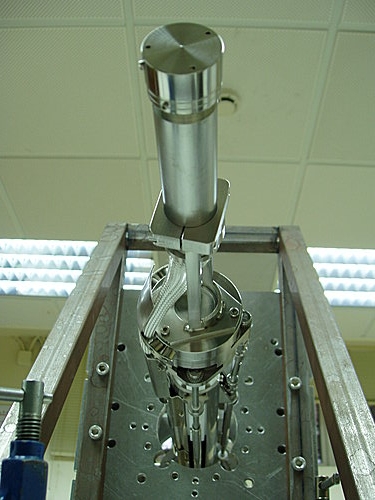TJ-II:Fast ion loss probe: Difference between revisions
(Created page with 'A mobile luminescent probe has been developed to detect fast ion losses and suprathermal ions escaping from the plasma of the TJ-II stellarator device. The priorities f…') |
(Updated reference links) |
||
| (3 intermediate revisions by the same user not shown) | |||
| Line 1: | Line 1: | ||
[[File:TJ-II_Fast_ion_loss_detector.jpg|375px|thumb|right|Fast Ion Loss Probe]] | |||
A mobile luminescent probe has been developed to detect fast ion losses and suprathermal ions escaping from the plasma of the [[TJ-II|TJ-II stellarator device]]. The priorities for its design have been flexibility for probe positioning, ease of maintenance, and detector sensitivity. It employs a coherent fiber bundle to relay, to the outside of the vacuum chamber, ionoluminescence images produced by the ions that impinge, after entering the detector head through a pinhole aperture, onto a screen of luminescent material. Ionoluminescence light detection is accomplished by a charge-coupled device camera and by a photomultiplier, both of which are optically coupled to the in-vacuum fiber bundle head by means of a standard optical setup. | A mobile luminescent probe has been developed to detect fast ion losses and suprathermal ions escaping from the plasma of the [[TJ-II|TJ-II stellarator device]]. The priorities for its design have been flexibility for probe positioning, ease of maintenance, and detector sensitivity. It employs a coherent fiber bundle to relay, to the outside of the vacuum chamber, ionoluminescence images produced by the ions that impinge, after entering the detector head through a pinhole aperture, onto a screen of luminescent material. Ionoluminescence light detection is accomplished by a charge-coupled device camera and by a photomultiplier, both of which are optically coupled to the in-vacuum fiber bundle head by means of a standard optical setup. | ||
<ref>[ | <ref>C. Burgos et al, ''Conceptual designs of fast-ion loss detectors for the TJ-II stellarator'', [[doi:10.1063/1.1534911|Rev. Sci. Instrum. '''74''' (2003) 1861]]</ref> | ||
<ref>D. Jiménez-Rey et al, ''A flexible luminescent probe to monitor fast ion losses at the edge of the TJ-II stellarator'', [[doi:10.1063/1.2979013|Rev. Sci. Instrum. '''79''' (2008) 093511]]</ref> | |||
The probe is located in [[TJ-II:Sectors|sector]] D3, at φ = -65º. | |||
== References == | == References == | ||
<references /> | <references /> | ||
Latest revision as of 18:58, 3 April 2018
A mobile luminescent probe has been developed to detect fast ion losses and suprathermal ions escaping from the plasma of the TJ-II stellarator device. The priorities for its design have been flexibility for probe positioning, ease of maintenance, and detector sensitivity. It employs a coherent fiber bundle to relay, to the outside of the vacuum chamber, ionoluminescence images produced by the ions that impinge, after entering the detector head through a pinhole aperture, onto a screen of luminescent material. Ionoluminescence light detection is accomplished by a charge-coupled device camera and by a photomultiplier, both of which are optically coupled to the in-vacuum fiber bundle head by means of a standard optical setup. [1] [2]
The probe is located in sector D3, at φ = -65º.
References
- ↑ C. Burgos et al, Conceptual designs of fast-ion loss detectors for the TJ-II stellarator, Rev. Sci. Instrum. 74 (2003) 1861
- ↑ D. Jiménez-Rey et al, A flexible luminescent probe to monitor fast ion losses at the edge of the TJ-II stellarator, Rev. Sci. Instrum. 79 (2008) 093511
